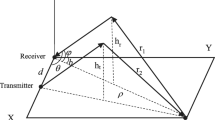Abstract
The performance of detector limits the overall performance of laser ranging system. And the design of multi-hit detector is one of the feasible ways to promote the performance of detector. Currently, the segmentation method or the recursive method is commonly used to analyze the multi-hit detector model. To the best of our knowledge, this paper is the first to propose a combinatorial method to solve the multi-hit detector model from the perspective of discrete time. Then, universal formulas of total signal detection probability and the average count are deduced based on the Poisson distribution signal. Furthermore, analysis is made to figure out how the average count changes with different parameters, such as the dead time, gating time, rate intensity. As a result, for GM-APD, the multi-hit detector model is verified advantageously compared to the single-hit detector model in improving the average count theoretically. Meanwhile, a discrete step feature is presented when average count changes with dead time or the gating time, which is of great significance in gating time optimization.
Similar content being viewed by others
References
Akiba M, Tsujino K, Sasaki M. Ultrahigh-sensitivity single-photon detection with linear-mode siliconavalanche photodiode. Opt Lett, 2010, 35: 2621–2623
Williams G M, Huntington A S. Probabilistic analysis of linear mode vs. Geiger mode APD FPAs for advanced LADAR enabled interceptors. In: Defense and Security Symposium. International Society for Optics and Photonics, 2006. 622008-622008-14
Renker D. Nuclear instruments and methods in physics research section A: Accelerators, spectrometers, detectors and associated equipment. In: Proceedings of the 4th International Conference on New Developments in Photodetection BEAUNE 2005. Beaune, 2006. 567: 48–56
Li Z, Li Y. Design and realization of a 10 Hz diffuse reflection laser ranging control system. Astron Res Tech. 2012, 9: 302–307
Kirchner G, Koidl F, Friederich F, et al. Laser measurements to space debris from Graz SLR station. Adv Space Res, 2013, 51: 21–24
Cova S, Ghioni M, Lacaita A, et al. Avalanche photodiodes and quenching circuits for single-photon detection. Appl Optics, 1996, 35:1956–1976
Stipcevic M. Active quenching circuit for single-photon detection with Geiger mode avalanche photodiodes. Appl Optics, 2009, 48: 1705–1714
Bronzi D, Tisa S, Villa F, et al. Fast sensing and quenching of CMOS SPADs for minimal afterpulsing effects. IEEE Photonic Tech L, 2013, 25: 776–779
Verghese S, Donnelly J P, Duerr E K, et al. Arrays of InP-based avalanche photodiodes for photon counting. IEEE J Sel Top Quant, 2007, 13: 870–886
Fouche D G. Detection and false-alarm probabilities for laser radars that use Geiger-mode detectors. Appl Optics, 2003, 42: 5388–5398
O’Brien M E, Fouche D G. Simulation of 3D laser radar systems. Linc Lab J, 2005, 15: 37–60
Henriksson M. Detection probabilities for photon-counting avalanche photodiodes applied to a laser radar system. Appl Optics, 2005, 44: 5140–5147
Johnson S, Gatt P, Nichols T. Analysis of Geiger-mode APD laser ranging. P SPIE, 2003, 5086: 359–368
Gatt P, Johnson S, Nichols T. Dead-time effects on Geiger-mode APD performance. In: Defense and Security Symposium. International Society for Optics and Photonics, 2007. 65500I-65500I-12
Gatt P, Johnson S, Nichols T. Geiger-mode avalanche photodiode ladar receiver performance characteristics and detection statistics. Appl Optics, 2009, 48: 3261–3276
Oh M S, Kong H J, Kim T H, et al. Time-of-flight analysis of threedimensional imaging laser radar using a Geiger-mode avalanche photodiode. Jpn J Appl Phys, 2010, 49: 026601
Oh M S, Kong H J, Kim T H, et al. Development and analysis of a photon-counting three-dimensional imaging laser detection and ranging (LADAR) system. Josa A, 2011, 28: 759–765
Goodman J W. Statistical Optics. New York: Wiley-Interscience, 1985
Ricklefs R L, Shelus P J. Poisson filtering of laser ranging data. In: Proceedings of 8th International Workshop on Laser Ranging. Maryland NASA Conference Publication, 1992. 26–29
Author information
Authors and Affiliations
Corresponding author
Rights and permissions
About this article
Cite this article
Zhao, P., Zhang, Y., Qian, W. et al. Investigation of Geiger-mode detector in multi-hit model for laser ranging. Sci. China Technol. Sci. 58, 943–950 (2015). https://doi.org/10.1007/s11431-015-5813-4
Received:
Accepted:
Published:
Issue Date:
DOI: https://doi.org/10.1007/s11431-015-5813-4




